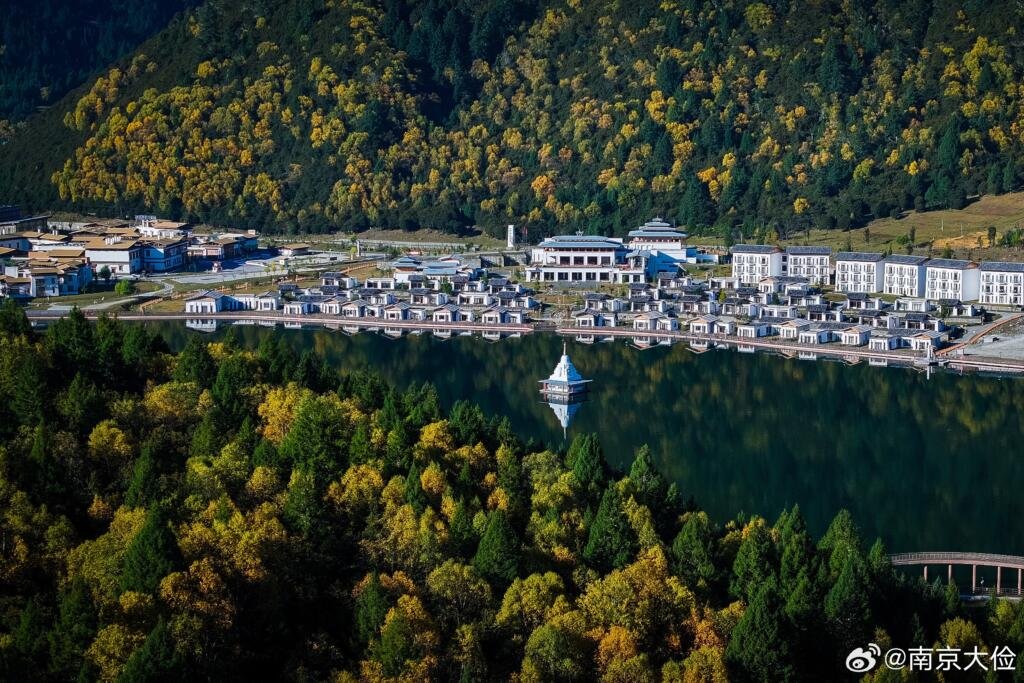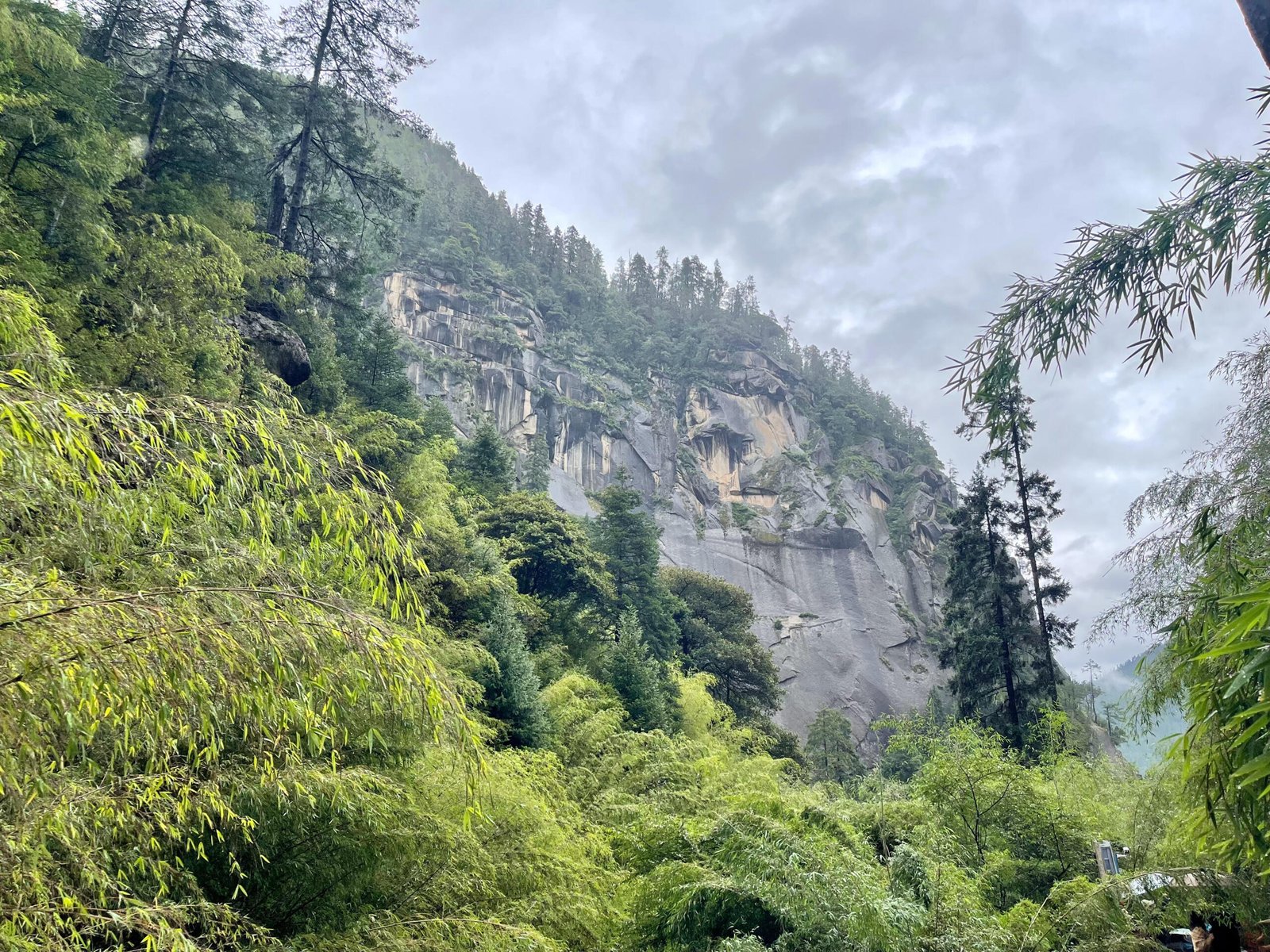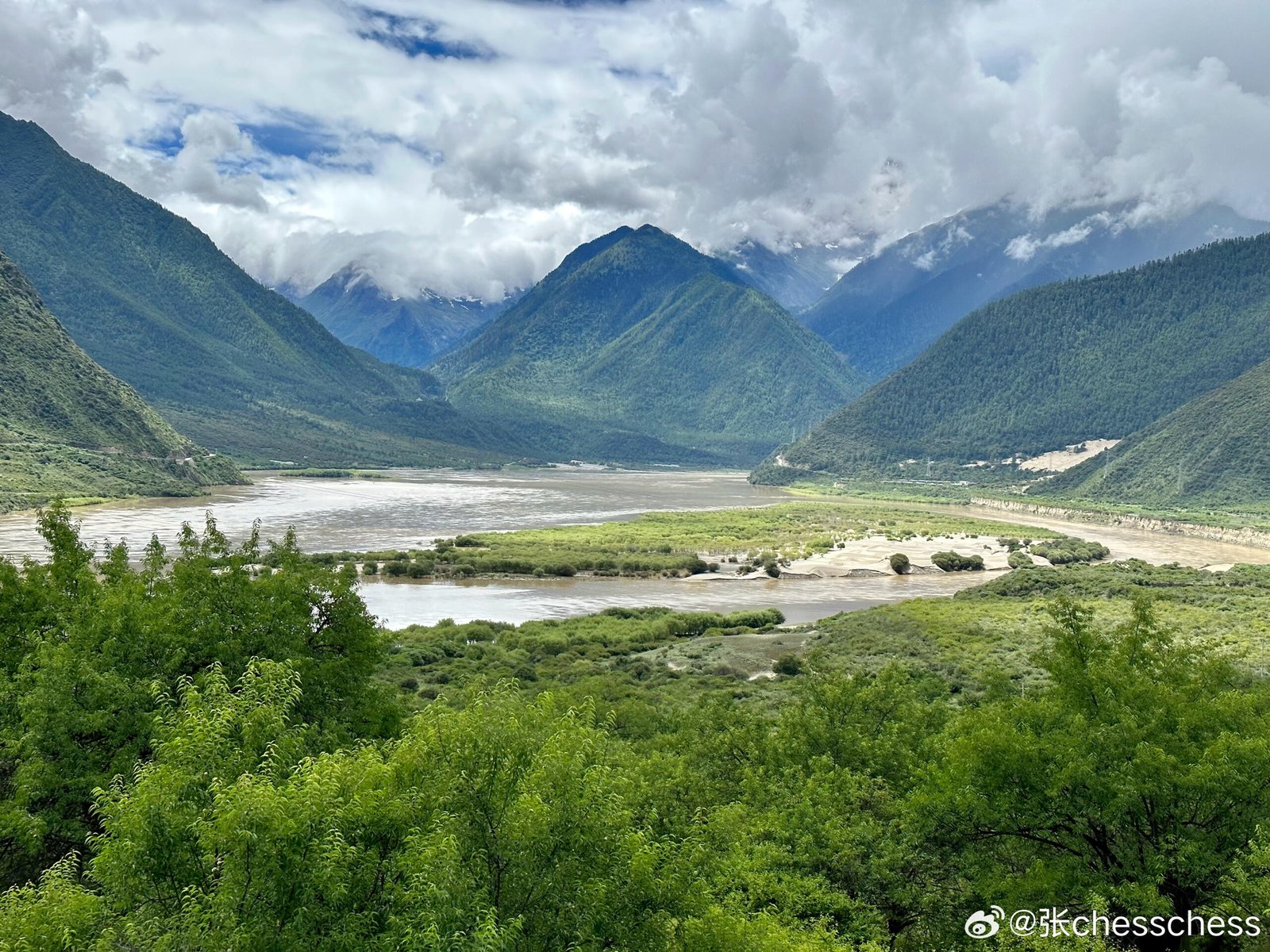Nyingchi: The Throne of the Sun
Nyingchi, with its roots in the Tibetan language as ཉིང་ཁྲི་ translates beautifully to “The Throne of the Sun.” This enchanting city, wrapped in the mystique of Tibet, holds a story that dates back to ancient times. The name itself is a tribute to the Nyang family, significant in the region’s history, indicating Nyingchi as a place of importance and reverence.
The name ‘Nyingchi’ originates from Tibetan “nyang-khri,” meaning “the throne of the Nyang family,” with “nyang” referring to the Nyang family in Nyingchi and “khri” to the Chishi family of the eastern Taidai during the Tubo period. After 1959, Chinese survey teams named the area Nyingchi based on local produce characteristics, a name that has been used ever since.
Bayi District: (བྲག་ཡིབ་ཆུས།) The Heart of Nyingchi
Geographical Coordinates
Bayi District, originally known as Nyingchi County, boasts an ancient history traceable to prehistoric Tibet. Located on the northern banks of the Yarlung Zangbo River and downstream of the Nyang River, Bayi is surrounded by natural beauty. It shares borders with Mêdog to the east, Milin to the south, Gongbo’gyamda to the west, and Bomi to the north, covering a vast area from 29.21°N to 30.15°N latitude and 93.27°E to 95.17°E longitude.

The Formation and Evolution
The transformation of Nyingchi County into the contemporary Bayi District is a tale of growth and development. Established as a county in September 1959, it evolved significantly over the years. In March 2015, the State Council approved the establishment of Bayi District, marking a new chapter. Officially inaugurated in June 2015, Bayi spans an impressive 10,238 square kilometers, featuring fertile lands, expansive pastures, and dense forests.
As of 2024, Bayi District governs 2 urban streets, 4 towns, and 3 townships, encompassing 69 villages and 4 communities. With a diverse population of over 84,254 residents as of November 2020, it’s a melting pot of cultures, primarily Tibetan, along with Menba, Luoba, Hui, Han, and several other ethnic groups. The government’s relocation to Bayi Town in October 2005 marked a significant milestone, further solidifying its status as a hub of administration and culture.
| Name | Chinese | Hanyu Pinyin | Tibetan | |||
|---|---|---|---|---|---|---|
| Subdistricts | ||||||
| Baimagang Subdistrict | 白玛岗街道 | Báimǎgǎng Jiēdào | པད་མ་སྒང་ཁྲོམ་ལམ་། | |||
| Jomo Subdistrict | 觉木街道 | Juémù Jiēdào | ཇོ་མོ་ཁྲོམ་ལམ་། | |||
| Towns | ||||||
| Nyingchi Town | 林芝镇 | Línzhī zhèn | ཉིང་ཁྲི་གྲོང་རྡལ། | |||
| Bêba Town | 百巴镇 | Bǎibā zhèn | སྤྲེ་པ་གྲོང་རྡལ། | |||
| Chagyib Town (Bayi) | 八一镇 | Bāyī zhèn | བྲག་ཡིབ་གྲོང་རྡལ། | |||
| Lunang Town | 鲁朗镇 | Lǔlǎng zhèn | ཀླུ་ནང་གྲོང་རྡལ། | |||
| Townships | ||||||
| Puqu Township | 布久乡 | Bùjiǔ xiāng | བུ་ཆུ་ཤང་། | |||
| Mairi Township | 米瑞乡 | Mǐruì xiāng | སྨད་རི་ཤང་། | |||
| Güncang Monba Ethnic Township | 更章门巴族乡 | Gēngzhāng Ménbāzú xiāng | དགུན་ཚང་མོན་པ་མི་རིགས་ཤང་། | |||
Escaping Poverty and Achieving Unity
Bayi’s journey towards prosperity and harmony is noteworthy. Achieving the status of being removed from the list of impoverished counties in October 2017, it stands as a testament to the region’s progress. It’s celebrated as one of the national models for ethnic unity and development, showcasing the power of collective effort and cultural integration.
The Geography and Climate of Bayi
Terrain and Altitude
The geography of Bayi District is a testament to the majestic and rugged beauty of Tibet. With an average elevation of 3,000 meters above sea level, the district features a mix of steep terrains and river valleys. The highest peak, Gala Bai’le at the boundary with Milin County, reaches an impressive 7,294 meters, illustrating the dramatic elevation changes within the region.
Climate: A Highland Haven
Bayi’s climate is a rarity in the high-altitude context of Tibet. Classified as a temperate, semi-humid monsoon climate, it offers a mild and wet environment, making it a unique ecological zone. The district enjoys an annual precipitation of 654 mm, mainly between May and September, ensuring a lush and vibrant landscape. With an average temperature of 8.6°C and over 2,022 hours of sunshine yearly, it provides a relatively gentle climate, distinct from the harsh conditions often associated with high altitudes.
Wildlife and Vegetation
Nyingchi is home to over 2,000 species of wildlife, including musk deer, leopards, black bears, brown bears, wolves, foxes, marmots, otters, parrots, and cuckoos. Among these, four species are under first-class national protection, and 62 are under second-class protection. The region’s flora includes numerous tree species such as spruce, fir, birch, elm, lacquer, high mountain pine, and larch.
With over 6,000 species of wild plants, including more than 1,000 with medicinal values such as cordyceps, gastrodia elata, fritillaria, notoginseng, codonopsis, angelica, rhodiola, and arisaema, Nyingchi is a veritable green treasury. Edible fungi like silver ear, black fungus, truffles, hericium, pipa, and reishi mushrooms are abundant. The area is also rich in minerals like gold, silver, copper, iron, tin, quartz, asbestos, gypsum, and tourmaline.
Signature Products
Bayi District boasts a diverse economy with agriculture, animal husbandry, and forestry, making it one of Tibet’s main grain-producing areas. In October 2017, it was officially removed from the list of impoverished counties, thanks to its diverse plant life ranging from subtropical to cold climate species, earning it nicknames like “the Jiangnan of Tibet,” “the Switzerland of Tibet,” and “the green treasury of Tibet.” Signature products include musk, bear bile, reishi mushrooms, cordyceps, hericium mushrooms, gastrodia elata, Tibetan sanqi, and highland fish, with apples leading in production quality and quantity in Tibet. Walnut production is also notable.
The region is famous for its buttered tea barrels, meticulously crafted from wooden planks with copper-bound edges and decorated with various patterns, reflecting exquisite craftsmanship. The red birch of Nyingchi is considered the best material for these barrels, highlighting the area’s rich cultural heritage and natural bounty.
Nyingchi’s enchanting landscapes, rich biodiversity, and vibrant culture make it a must-visit destination for those seeking to explore the hidden wonders of Tibet. Its commitment to conservation and sustainable development ensures that this beautiful region remains a pristine paradise for generations to come.
Discovering the Treasures of Tibet: Specialty Products of Nyingchi
Nyingchi, a region celebrated for its breathtaking landscapes and rich biodiversity, is also home to some of Tibet’s most prized specialty products. Among these, three stand out for their unique benefits and cultural significance: Lingzhi mushrooms, Lion’s Mane mushrooms, and Tibetan Sanqi. Let’s explore these remarkable treasures and their applications in traditional medicine and culinary arts.
Ganoderma: The Mushroom of Immortality
Ganoderma (灵芝), known in Tibetan as “Gorsha Serpo” and also referred to as “灵芝菌” or “灵芝草” belongs to the class of polypore mushrooms within the fungi kingdom. This decomposer grows to heights of 10-20 cm, with kidney-shaped to nearly circular caps that can reach sizes of 12 cm by 20 cm. The caps are about 2 cm thick, purple-brown with a varnished appearance and cloud-like patterns, and are supported by stems of varying lengths.
Historically revered by medical scholars as a tonic for strengthening the body and fortifying the essence, Ganoderma (Lingzhi) has been documented in ancient texts for its myriad health benefits. These include improving hearing, benefiting the joints, preserving the spirit, boosting vital energy, strengthening the sinews and bones, and enhancing complexion. Modern science supports these claims, finding Ganoderma (Lingzhi) rich in amino acids, proteins, vitamins, alkaloids, glycosides, steroids, enzymes, essential oils, and other nutrients necessary for human health. Traditional Tibetan medicine prescribes Ganoderma (Lingzhi) for conditions like nervous weakness, coronary heart disease, hypertension, chronic bronchitis, chronic hepatitis, nephritis, ulcer diseases, and diabetes, and recent research points to its potential in cancer treatment.
Lion’s Mane: A Culinary and Medicinal Marvel
Hericium erinaceus (The Lion’s Mane mushroom) or “Sheba” in Tibetan, is a sight to behold in the forests of the Bayi District. Growing on old but living oak trees, this mushroom resembles a white or pale yellow “furball,” with a surface covered in tender filaments that turn yellow or brown upon drying, much like a monkey’s fur. Belonging to the tooth fungus family, the Lion’s Mane (猴头) is covered in needle-like spines, appearing white with shades of pale yellow or pink from afar, similar to the fur of a golden monkey.
Renowned for its nutritional value, the Lion’s Mane mushroom contains peptides, polysaccharides, fats, and a variety of vitamins, contributing to cell vitality, longevity, and beauty. It’s considered both a precious medicine and a delicacy. Historical records praise its balanced nature and sweet taste, attributing digestive and organ benefits to its consumption. Modern medicine acknowledges Lion’s Mane as an effective immune booster, aiding in the recovery of post-operative patients and inhibiting malignant tumors, such as esophageal and gastric cancers.
Himalayan ginseng: The Blood Vitalizing Herb
Panax pseudoginseng, a gem in Tibetan pharmacology, is recognized alongside ginseng as one of the most valuable medicinal herbs. Recorded in the Qing Dynasty pharmacopeia “本草纲目拾遗” Himalayan ginseng, is a perennial herbaceous plant of the Araliaceae family, named for its cultivation cycle of 3-7 years and its characteristic three petioles each bearing seven leaflets.
Used in its entirety – roots, leaves, and flowers – in Tibetan medicine, Himalayan ginseng is known for its ability to stop bleeding, disperse blood stasis, alleviate pain, and remove blood stasis. It is sweet, slightly bitter, and warm in nature, effectively treating bruises, chest pain, abdominal masses, blood stasis, dysmenorrhea, postpartum abdominal pain, and sores, though it’s not recommended for menstrual disorders or imbalances caused by deficiency of qi and blood.
Himalayan ginseng is available in three forms: flowers, roots, and powdered roots, all highly valued for their medicinal properties. The flowers are harvested between June and August, with saponin content reaching over 13%, primarily used for lowering blood pressure and cholesterol. The roots are utilized for cardiovascular diseases, while powdered Himalayan ginseng, made from crushed roots, is second only to the flowers in medicinal value, particularly for heart and brain vascular conditions. It contains a rich array of bioactive saponins, amino acids, trace elements, anticancer selenium, and proteins.
Consumed raw, Himalayan ginseng powder treats bruises, external bleeding, postpartum fainting, vomiting blood, nosebleeds, and other blood disorders, and can help prevent coronary heart disease, hyperlipidemia, and hypertension. However, pregnant women should avoid it. When cooked, it’s used to nourish and invigorate the blood, aiding in weakness, poor appetite, nervous exhaustion, excessive fatigue, blood loss, and anemia, typically ingested with warm water.
These specialty products of Nyingchi not only highlight the region’s rich natural resources and cultural heritage but also offer insights into the traditional Tibetan approach to health and wellness, blending centuries-old wisdom with the needs of the modern world.
Travel and Transportation in Bayi District
Bayi District, located in Nyingchi, is a gateway to the enchanting landscapes of eastern Tibet. With its rich cultural heritage and breathtaking natural beauty, the region offers a unique blend of attractions for travelers. Here’s a comprehensive guide to navigating and experiencing Bayi District, from transportation tips to must-visit sites.
Getting to Bayi
Roads to Discovery
The journey to Bayi District from Lhasa covers 409.2 kilometers, mostly on smooth asphalt roads. This route, passing through Gongbogyamda, Mozhu Gongka, and Dazi counties, provides a comfortable and efficient travel option, taking approximately 5 hours. It’s considered one of the highest-grade highways for entering Bayi. For those coming from Chengdu, the Sichuan-Tibet Highway stretches over 1700 kilometers, with 223 kilometers lying within the district’s bounds. Bayi is also about 50 kilometers from Nyingchi Airport, making it easily accessible by various modes of transportation. The region boasts a comprehensive road network that connects 3 townships and 4 towns covering 67 administrative villages.
The Lhasa-Nyingchi Railway
The Lhasa-Nyingchi railway, the world’s highest-altitude electric railway, spans 403.144 kilometers. It weaves along the Lhasa River, passing through tunnels and over bridges, including the Duplung, Xierong, and Gongga tunnels, before reaching Bayi. Officially opened on June 25, 2021, this railway has injected new vitality into the region, enhancing accessibility and promoting tourism and economic development.
Practical Tips for Travelers
Transportation Channels
Five main routes lead to Bayi District, offering flexibility for travelers:
- By Air: Flights from Chengdu, Shanghai, Chongqing, and Lhasa provide direct access to Bayi.
- By Road from Lhasa: A 409.2-kilometer drive along the Sichuan-Tibet Highway through Dazi County and over the Mila Mountain to Bayi Town.
- From Chamdo: A 719-kilometer journey along National Highway 318, passing through Bomi and Lulang to reach Bayi Town.
- From Shannan Zêtang: Taking Provincial Road 306 into Lang County, then through Milin and over the Gangga Bridge to Bayi Town, covering 485 kilometers.
- From Yunnan Diqing: A longer route of 788 kilometers via the Yunnan-Tibet Highway or through Gongshan along the G214 highway, reaching Bayi via various scenic points.
Dining and Shopping
- Cuisine: Sichuan cuisine dominates local taste preferences, with numerous Sichuan restaurants throughout Bayi. To cater to tourists, exotic game restaurants are also available, though prices for specialties like Tibetan pig, Yajiang fish, Hericium mushrooms, and Tricholoma matsutake can be steep.
- Shopping: Bayi’s abundant natural forest resources offer a variety of economic and medicinal plants. Common goods include black fungus, mushrooms, bamboo shoots, Sichuan peppercorns, and star anise. For tourists, Nyingchi bamboo crafts, Menba wooden bowls, and Motuo stone pots are particularly attractive purchases.
Tourist Hotlines and Routes
- Hotlines: Bayi offers three main tourist routes:
- Lhasa – Basong Lake – Bayi Town – Lhasa: This route connects major attractions like Basong Lake, Bayi Town, Lamaling Monastery, and Sejila Mountain, ideal for both leisure and scientific exploration.
- Lhasa – Bayi – Milin – Shannan: Highlighting natural scenery, cultural relics, and ethnic customs, this “Golden Tourism Line” is a journey through the heart of Tibetan culture.
- Lhasa – Bayi – Tongmai – Bomi – Ranwu – Bangda: Offering stunning landscapes, this route is challenging but rewards travelers with unparalleled views. From Bangda, visitors can fly back to Chengdu or continue along National Highway 318 for further exploration.
Travel Recommendations
- 6-Day Bayi Tour: Starting with a day in Lhasa (Potala Palace, Jokhang Temple, Barkhor Street), the tour takes you through Mila Mountain and Kading Valley to Bayi Town, followed by visits to Lulang, Palong, and Bomi, ending with Ranwu and the Midui Glacier before returning to Lhasa.
- 5-Day Bayi Tour: This itinerary begins with a flight from Chengdu to Nyingchi Airport, followed by visits to the Yarlung Tsangpo Scenic Area, ancient cypress forests, and Lulang, concluding with a return to Lhasa for city exploration and a trip to Namtso and Yangpachen.
Border Permits
For trips from Bayi to Milin or Motuo, travelers must obtain a border pass. If not processed at the place of residence, it can be obtained at the office next to the gate of the Bayi Town Armed Police detachment, open Monday to Friday.
Bayi’s Religious Heritage
Nyingchi City boasts 97 religious sites, including 49 monasteries, 21 Lhakhangs (scripture halls), and 27 retreats for monks. The religious landscape is diverse, with 26 Gelugpa, 9 Kagyu, 46 Nyingma, and 5 Bon establishments. Over 600 monks and nuns (including more than 40 nuns) live here, making up 0.44% of the total agricultural and pastoral population. The region is home to historically renowned monasteries like Dimu, Qiangna, and Tashilhunpo, all dating back around 600 years.
In Bayi District, notable monasteries include Gerjia Monastery, Gengqin Monastery, Zhuosha Monastery, and Jiangjiulin Monastery in Nyingchi Town, as well as Daze Monastery, Sekagyunqin Monastery, and Nichi Scripture Hall in Daze Township, among others. This rich tapestry of religious sites offers visitors a deeper understanding of Tibetan Buddhism and its integral role in local culture.




